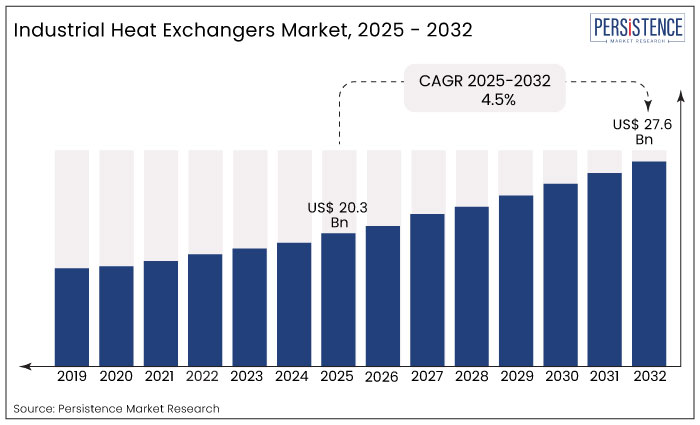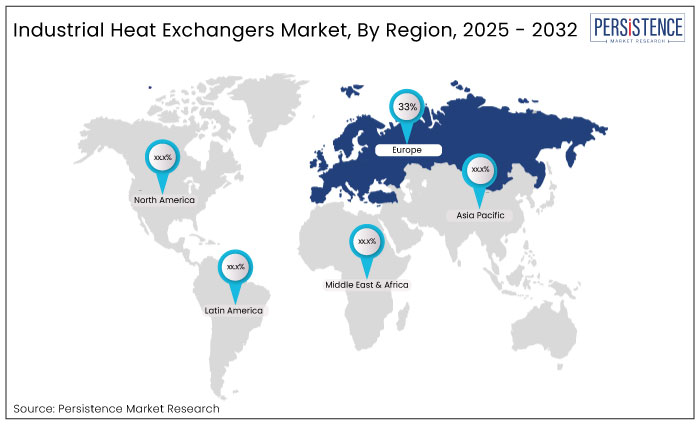Industry: Industrial Automation
Published Date: February-2025
Format: PPT*, PDF, EXCEL
Delivery Timelines: Contact Sales
Number of Pages: 165
Report ID: PMRREP30875
The industrial heat exchangers market is estimated to increase from US$ 20.3 Bn in 2025 to US$ 27.6 Bn by 2032. The market is projected to record a CAGR of 4.5% during the forecast period from 2025 to 2032. With end users focusing mainly on increasing operational efficiency, and reducing maintenance costs, the market is expected to grow positively in terms of value and volume over the forecast period.

Key Highlights of the Market
|
Market Attributes |
Key Insights |
|
Market Size (2025E) |
US$ 20.3 Bn |
|
Projected Market Value (2032F) |
US$ 27.6 Bn |
|
Global Market Growth Rate (CAGR 2025 to 2032) |
4.5% |
|
Historical Market Growth Rate (CAGR 2019 to 2024) |
4.1% |
|
Region |
Market Share in 2024 |
|
Europe |
33% |
Europe to dominate the market representing 33% of the market share. The demand for these goods in the HVAC & refrigeration industry is expected to increase due to the growing investments in public and private infrastructure.
The projected period is expected to witness expansion driven by the rising demand from various end-use industries for heat exchangers that provide increased durability, and improved efficiency.
The region's construction industry is a leading chemical purchaser and is projected to expand due to various factors including rising infrastructure spending and favourable lending rates. The heat exchangers market is projected to benefit from the anticipated stability in the demand for chemicals in the upcoming years.
The increasing investments in public and private infrastructure are anticipated to stimulate the need for heat exchangers in the HVAC & refrigeration sector. The industrial heat exchangers market is anticipated to be driven by the rising exploration and production operations in offshore regions during the projected timeframe.

|
Category |
Market Share in 2024 |
|
Product - Shell & Tube Heat Exchangers |
38% |
Based on product, the market is segmented into plate & frame heat exchanger, shell & tube heat exchanger and air-cooled heat exchanger. Among these, the shell & tube heat exchangers dominate the market.
Shell and tube goods consist of a collection of tubes arranged in a cylindrical shell, with the tubes aligned parallel to the shell's axis. The three predominant varieties of shell and tube products are the floating-head type, U-tube design, and fixed tube sheet design.
Shell and tube goods are utilized in applications that necessitate a broad range of temperatures and pressures, as well as the transfer of heat between two liquids, between liquids and gases, or between two gases.
The heat exchangers are straightforward and well-suited for transferring heat from steam to water. Nevertheless, the segment's expansion is expected to be impeded during the projection period due to the need for expansive areas.
|
Category |
Market Share in 2024 |
|
Material - Metals |
48% |
Based on material, the industrial heat exchangers market is segmented into metals and alloys. Among these, the metals segment owns the significant market share. The inherent characteristics of metal materials make them essential in heat exchangers. Metals to account for 48% of the market share in 2024.
Efficient heat transfer is ensured by high thermal conductivity as demonstrated by materials such as copper and aluminum. Metals that are resistant to corrosion such as stainless steel improve the longevity of an object by protecting it against decay. The ability to endure diverse environments is crucial necessitating a high level of mechanical strength.
The careful choice of these materials achieves a harmonious combination of thermal efficiency, durability, and cost-effectiveness highlighting their crucial role in maximizing the performance of heat exchange systems.
A heat exchanger is a mechanical device that transfers thermal energy from one fluid to another. Heat exchangers are commonly utilized in both cooling and heating processes. A barrier prevents the intermingling of liquids by effectively separating them.
Heat exchangers are widely employed for many reasons including residential heating, air conditioning, refrigeration, hydropower generation, waste management and more. A heat exchanger is commonly utilized in internal combustion engines, where coolant from the engine flows via radiator coils.
Rising Industrialization has increased the demand for equipment like Industrial Heat Exchangers. Increasing power generation capacities, surging energy prices as well as technological advancements in various industrial sectors are some of the driving factors of the market growth.
The rising prices for energy generations as well as stringent government protocols about the CO2 emissions are some other factors that tend to drive the industrial heat exchangers market. Industrial heat exchangers may be used primarily for the purpose of cooling down elements, or heating them up.
Cooling application is much more common given the need to prevent equipment and machinery from overheating. The increase in the use of industrial heat exchangers in the food & beverage sector, petrochemical industry as well as processing of hydrocarbons is expected to boost the market further.
The industrial heat exchangers market experienced steady growth during the period from 2019 to 2023 driven by the increasing demand across various industries such as chemical processing, oil and gas, power generation, and HVAC systems.
The market growth fueled by the rising industrialization in emerging economies particularly in Asia Pacific, and the need for energy-efficient processes to reduce operational costs. Stringent environmental regulations pushed industries to adopt advanced heat exchanger technologies that enhance energy efficiency and minimize emissions further driving market expansion.
The market is expected to witness accelerated growth propelled by technological advancements and the increasing adoption of renewable energy sources. As industries strive for greater sustainability, the demand for innovative heat exchanger solutions that can operate efficiently with renewable energy systems will likely to rise.
The growing focus on reducing carbon footprints and improving energy efficiency will drive investments in next-generation heat exchangers with enhanced performance characteristics. The market is also expected to benefit from modernizing aging infrastructure in developed economies, which will require replacing or upgrading existing heat exchanger systems.
Increased Demand for Energy Efficiency
The heightened focus on energy efficiency across various industries is a significant growth driver for the industrial heat exchangers market. Heat exchangers are critical components in industrial processes for transferring heat between fluids, and their efficiency directly impacts energy consumption and operational costs.
As industries strive to reduce energy consumption and comply with stringent environmental regulations, there is a growing demand for advanced heat exchangers that offer improved thermal performance and energy savings.
Innovations such as compact, high-efficiency designs and materials that enhance heat transfer rates are becoming increasingly popular, which drives towards energy efficiency. This not only helps reduce operational expenses but also supports global sustainability goals by minimizing the carbon footprint of industrial operations fuelling market growth.
Technological Advancements and Innovations
Technological advancements and innovations in heat exchanger design and materials significantly contribute to market growth. The development of new technologies such as advanced compact heat exchangers and enhanced materials like corrosion-resistant alloys and high thermal conductivity composites is pushing the boundaries of performance and efficiency.
Innovations such as microchannel and regenerative heat exchangers offer improved heat transfer rates and reduced energy consumption. Integrating digital technologies, including sensors and IoT capabilities, allows for better monitoring and optimizing heat exchanger performance.
Advancements address the evolving needs of various industries and drive the adoption of next-generation heat exchangers contributing to the market growth.
Fluctuating Raw Material Prices
Fluctuating raw material prices represent another significant restraint impacting the industrial heat exchangers market. The cost of materials such as metals and alloys, essential for manufacturing heat exchangers, can vary significantly due to market conditions, trade policies, and supply chain disruptions.
Fluctuations in the prices of stainless steel or copper can increase production costs for heat exchanger manufacturers. These price variations can affect the overall pricing of heat exchangers, making them more expensive for end-users and potentially slowing down adoption rates.
Key manufacturers may face challenges in managing cost structures and maintaining profitability amidst volatile raw material prices, which can impact their ability to invest in new technologies and innovations.
Growth in Renewable Energy Sector
One significant opportunity for the market lies in the growth of the renewable energy sector. As the global focus shifts toward sustainable and clean energy sources, there is a rising demand for technologies that enhance the efficiency and effectiveness of renewable energy systems.
Heat exchangers are crucial in several renewable energy applications such as geothermal energy, solar thermal systems, and bioenergy. In geothermal energy systems, heat exchangers transfer heat from the Earth's core to the fluid that generates electricity making them vital components in geothermal power plants.
In solar thermal systems, heat exchangers facilitate the transfer of heat collected from solar collectors to the working fluid, which is then used to generate steam or hot water. The increasing deployment of solar thermal technology, driven by residential and industrial applications, presents a significant growth opportunity for heat exchanger manufacturers.
As governments and organizations invest in renewable energy projects to meet carbon reduction targets and transition to sustainable energy sources, the demand for high-performance heat exchangers in these applications is expected to grow. Heat exchanger manufacturers can capitalize on this opportunity by aligning product offerings with the needs of the renewable energy sector and investing in innovative solutions that cater to these applications.
The market is competitive featuring a mix of established global players and regional firms. Key global companies such as Alfa Laval, heat exchangers, and SPX FLOW dominate due to their extensive product portfolios, technological advancements, and international distribution networks.
Regional players especially in Asia Pacific compete by providing cost-effective solutions tailored to local market needs. The market is also witnessing increased competition from emerging companies specializing in niche segments such as compact and high-performance heat exchangers.
Companies are investing in research and development to enhance product performance and meet evolving industry standards, intensifying the competitive landscape.
Recent Industry Developments in the Industrial Heat Exchangers Market
|
Attributes |
Details |
|
Forecast Period |
2025 to 2032 |
|
Historical Data Available for |
2019 to 2024 |
| Market Analysis Units | Value: US$ Bn/Mn, Volume: As applicable |
|
Key Regions Covered |
|
|
Key Market Segments Covered |
|
|
Key Companies Profiled |
|
| Report Highlights |
|
|
Customization & Pricing |
Available upon request |
By Product
By Material
By End Use
By Region
To know more about delivery timeline for this report Contact Sales

The market is estimated to be valued at US$ 27.6 Bn by 2032.
The market is anticipated to exhibit a CAGR of 4.5% during the forecast period.
A few of the leading industry players in the market are Alfa Laval, Danfoss, Kelvion Holding GmbH, and Güntner Group GmbH.
Technological advancements and innovations are a key factor for market growth.
Shell & tube heat exchangers to be the top products category.